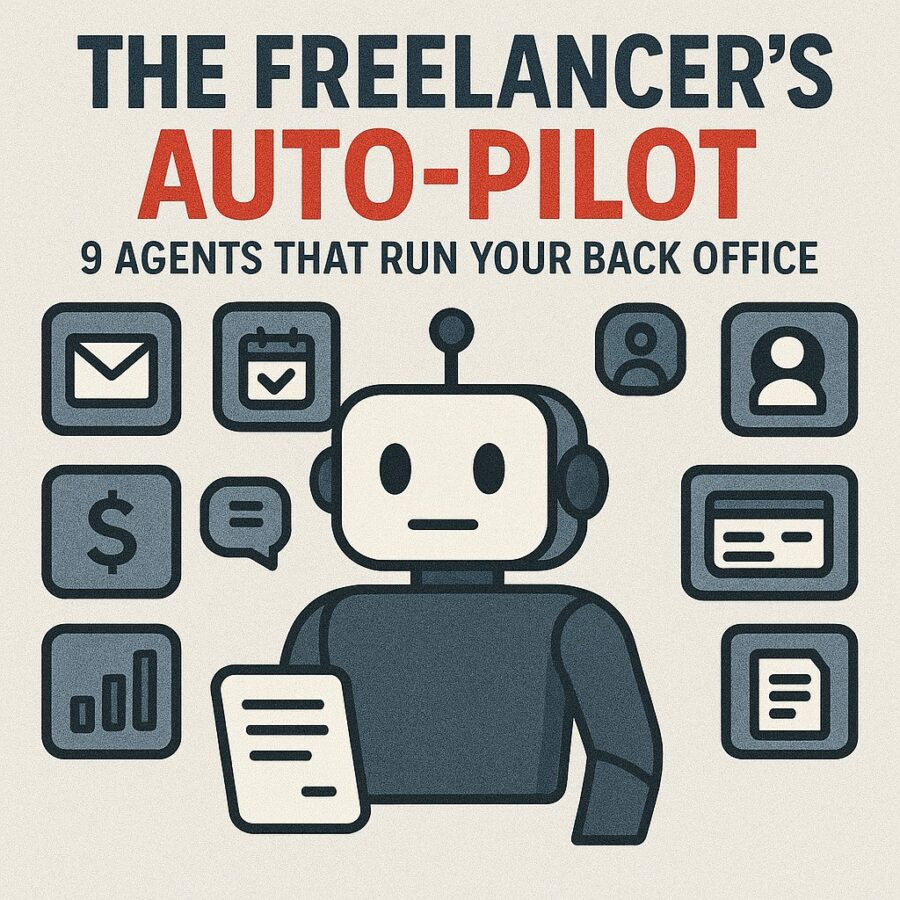Views: 2
Your calendar accepts a new client call while you sleep. Draft invoices go out at noon and unpaid ones get nudged at 4 p.m. Expenses code themselves. Meeting notes appear in your project board without you lifting a finger. That is not sci-fi. That is The Freelancer’s Auto-Pilot: 9 Agents That Run Your Back Office, a small system of specialized AI helpers that each own one chore and never complain about Mondays.
Agentic tech matured fast. Production teams now deploy multi-agent workflows for research, customer support, and operations, with a majority of surveyed orgs already using agents in real workloads. Freelancers can tap the same playbook to erase repetitive admin and redirect hours toward billable craft. (LangChain)
Below is a practical field guide to build your own “The Freelancer’s Auto-Pilot: 9 Agents That Run Your Back Office.” You will see what each agent does, which stack to consider, the guardrails to set, and the prompt scaffolds to copy.
Before we dive in, bookmark a few resources on Alt+Penguin that pair well with this build: the living list of Posts for tactics and case studies, the free Downloads library for checklists, and the Shop for prompt packs like the 1100 Prompt Bundle PLR Pack. If you want to sharpen reasoning patterns the agents can reuse, read our piece on Master Chain-of-Thought Prompting. (Alt+Penguin)
Choosing the spine for The Freelancer’s Auto-Pilot
Modern agent stacks give you three sensible routes.
- Plug-and-play agents inside established platforms. Microsoft Copilot Studio lets you design agents that click through apps and websites on your behalf, which is useful when a tool has no API. This “computer use” capability can operate spreadsheets, fill web forms, and adapt as interfaces change. (The Verge)
- Workflow automation with AI-native teammates. Zapier Agents create custom “AI teammates” that act across more than eight thousand apps, combining your knowledge base with triggers and actions. This is ideal for freelancers who live inside Gmail, Google Drive, Slack, Stripe, Calendly, and Notion. (Zapier)
- Agent frameworks for builders and tinkerers. If you want full control, frameworks like LangChain and its LangGraph toolkit power production multi-agent systems for research, analysis, and operations. Their public case studies show agents compressing tasks from days to minutes in real deployments. (LangChain Blog)
OpenAI’s recent shift toward a dedicated Agents platform, with Responses API, built-in tools like Web Search and File Search, and an SDK with tracing, also matters for freelancers who want stable building blocks and observability. (OpenAI Help Center)
With the spine picked, it is time to assemble The Freelancer’s Auto-Pilot: 9 Agents That Run Your Back Office.
Affiliate Link
See our Affiliate Disclosure page for more details on what affiliate links do for our website.
1) Inbox Triage Agent
Purpose: Keep your inbox at zero by clustering messages, drafting replies, and routing tasks to the right app.
What it does: Labels leads, clients, and vendors. Drafts replies for common requests. Sends scheduling links. Files receipts to your accounting tool.
Suggested stack: Zapier Agents for Gmail or Outlook, connected to Notion, Google Drive, and your CRM. If you work in Microsoft 365, Copilot Studio can read, classify, and act across Outlook, OneDrive, and Teams. (Zapier)
Guardrails: Whitelist domains allowed to trigger automated replies. Require human approval for new-client emails.
Prompt: Prompt: Triage the last 50 unread emails. Create three buckets: Leads, Current Clients, Admin. Draft short replies for each message, include a Calendly link for Leads, push tasks to Notion with due dates, and attach the email thread URL.
KPI to watch: Percentage of messages handled without manual edits.
Add internal learning over time. Store good replies in a Notion page linked from your Downloads checklist to improve tone consistency. (Alt+Penguin)
2) Scheduling Agent
Purpose: Eliminate the back-and-forth of finding times.
What it does: Shares the right booking page, detects time zones, buffers meetings, and auto-sends reminders.
Suggested stack: Calendly remains a pragmatic hub, with routing forms and automated reminders for one-to-one and multi-person scheduling. Use Zapier Agents to auto-create meeting notes documents when bookings land. (Calendly.com)
Guardrails: Block “same-day” bookings. Enforce breaks between calls.
Prompt: Prompt: When a prospect asks for time, reply with a concise, friendly email and include the correct Calendly link for discovery calls. Confirm timezone and offer two backup times.
KPI to watch: Time from first email to confirmed slot.
Link this agent from your website footer or your Shop service items where clients often browse offers before booking. (Alt+Penguin)
3) Proposal and Contract Agent
Purpose: Turn scoping calls into ready-to-sign proposals and agreements.
What it does: Pulls call notes, inserts pricing tables, populates client info, and sends contracts for e-signature.
Suggested stack: Use your doc tool of choice and connect it to an e-signature platform. For payment terms and deposits, integrate billing through Stripe Invoicing with automated reminders and smart retries, so signed deals convert into cash with fewer failures. (Stripe)
Guardrails: Require your review before sending any agreement over a threshold.
Prompt: Prompt: Draft a two-page proposal with scope, milestones, and payment schedule based on these notes. Prepare an invoice for a 40 percent deposit and schedule it to send after signature with due in 5 days.
KPI to watch: Proposal acceptance rate and time to signature.
Affiliate Link
See our Affiliate Disclosure page for more details on what affiliate links do for our website.

4) CRM and Pipeline Agent
Purpose: Keep your deal flow accurate without data entry.
What it does: Logs calls, updates stage, sets next steps, and pings you when deals stall.
Suggested stack: If you live in HubSpot, their new Breeze AI Agents handle prospecting, content drafts, and knowledge responses inside the CRM. Agentic tools like Sweep also automate go-to-market workflows across Salesforce and HubSpot, showing where AI nudges deals forward. (HubSpot)
Guardrails: Prevent pipeline edits on closed-won records unless approved.
Prompt: Prompt: After each client call, summarize action items, set the next task date, update the pipeline stage, and tag the likelihood to close this month.
KPI to watch: Percent of opportunities with a next step and a recent note.
Remind yourself of messaging patterns with our Posts library on positioning and scripts. (Alt+Penguin)
5) Bookkeeping and Expense Coding Agent
Purpose: Close your books faster with fewer errors.
What it does: Reads receipts, assigns categories, attaches PDFs, and flags anomalies that need review.
Suggested stack: QuickBooks now promotes Intuit AI agents that auto-organize expenses and accelerate bookkeeping. Xero’s ecosystem lists AI apps for bill capture and payables automation. You can even stitch a free template using a Zapier-powered agent that forwards bills by email and creates drafts in Xero with lines coded and taxes applied. (QuickBooks)
Guardrails: Any new vendor over a set amount requires human approval.
Prompt: Prompt: Monitor the “Receipts” inbox. For each PDF, extract vendor, date, amount, tax, and line items. Create or update the bill in my accounting tool, attach the file, and assign the category based on my chart of accounts.
KPI to watch: Percentage of transactions auto-coded with no edits.
If you sell digital products, check revenue data twice monthly. Our Shop items like Alt+Penguin Prompt Pack #2 are good test cases for automated revenue mapping by SKU. (Alt+Penguin)
Affiliate Link
See our Affiliate Disclosure page for more details on what affiliate links do for our website.
6) Invoicing and Collections Agent
Purpose: Get paid on time with fewer awkward follow-ups.
What it does: Generates invoices, schedules payment reminders, retries failed cards, and surfaces churn risks.
Suggested stack: Stripe Billing supports automated invoice creation, payment reminders, dunning with Smart Retries, partial payments, and consolidated invoices. These features reduce failure rates and smooth cash flow for solo operators. (Stripe)
Guardrails: Never send an invoice without a matching signed agreement.
Prompt: Prompt: For all active projects, generate monthly invoices on the first business day. Include purchase order numbers where available. If an invoice goes unpaid for 7 days, send a friendly reminder. If it fails again, schedule a call and add a note in the CRM.
KPI to watch: Days sales outstanding and recovery rate after first retry.
To align copy tone and payment terms, reuse snippets from our Posts and templates in Downloads. (Alt+Penguin)
7) Meeting Notes and Task Capture Agent
Purpose: Walk out of calls with clean notes and immediate next steps.
What it does: Records or imports transcripts, extracts decisions, assigns tasks, and publishes summaries to your project board.
Suggested stack: Use your preferred call platform with transcription, then route outputs to Notion or your task system via Zapier Agents. Multi-agent orchestration frameworks can improve reliability when turning messy transcripts into structured action items. (Zapier)
Guardrails: Comply with regional recording laws and share disclosure scripts.
Prompt: Prompt: Convert this transcript into a one-page brief: goals, decisions, risks, action items by owner and due date. Publish it to the project wiki and notify the client with a link.
KPI to watch: Tasks captured per meeting and on-time completion.
Affiliate Link
See our Affiliate Disclosure page for more details on what affiliate links do for our website.
8) Research and Briefing Agent
Purpose: Prepare competitive snapshots, pricing benchmarks, and market briefs before proposals or strategy sessions.
What it does: Crawls sources, filters noise, drafts briefs with citations, and updates as facts change.
Suggested stack: For deeper research, multi-agent frameworks like LangChain with LangGraph show strong, real-world performance at speed and scale. Use OpenAI’s new Agents building blocks with Web Search to keep sources visible and traceable. (LangChain Blog)
Guardrails: Enforce source lists, block untrusted domains, and require human review before external delivery.
Prompt: Prompt: Build a one-page brief on the client’s industry. Include market size, top competitors, recent funding news, and regulatory notes. Cite at least five primary sources and provide links.
KPI to watch: Lead-to-proposal conversion when a brief is attached.
Publish anonymized briefs as portfolio posts to your Posts feed and interlink them with your service pages for SEO depth. (Alt+Penguin)
Affiliate Link
See our Affiliate Disclosure page for more details on what affiliate links do for our website.
9) Compliance, File, and Knowledge Agent
Purpose: Keep assets organized, searchable, and shareable.
What it does: Names files consistently, stores the right artifacts in the right folders, updates your SOP wiki, and answers “where is X” questions.
Suggested stack: Copilot Studio or an OpenAI-based agent with File Search can manage knowledge retrieval. Zapier Agents can enforce naming rules and directory placement across Google Drive and Dropbox. (Microsoft)
Guardrails: Use read-only access for archives. Log every deletion as a change request.
Prompt: Prompt: When a project closes, archive all assets to the “Client Project Archive” folder with standardized names, update the SOP page with final links, and generate a one-page handoff summary.
KPI to watch: Time to locate a document and the number of duplicate files.
Putting it all together: your weekend build plan
Day 1 morning: Map your workflows. Sketch the path from lead to invoice to archive. Every handoff becomes a candidate for The Freelancer’s Auto-Pilot: 9 Agents That Run Your Back Office.
Day 1 afternoon: Wire the spine. If you want a no-code start, create two Zapier Agents: one for “Inbox to Notion” and one for “Booking to Notes.” If you are all-in on Microsoft 365, create a Copilot Studio agent with “computer use” to interact with any desktop app that lacks an API. (Zapier)
Day 2 morning: Add money flows. Connect Stripe Billing and switch on automated reminders and Smart Retries. If you use QuickBooks or Xero, enable the AI bookkeeping features or the bill-capture apps in the marketplace. (Stripe)
Day 2 afternoon: Write your SOPs and prompts. Keep a single page that lists each agent’s scope, rules, and emergency stop. Store it in your private wiki and put a copy in your Downloads area for your future self. (Alt+Penguin)
Safety, privacy, and control
A freelancer’s reputation rides on trust. Keep yours with simple rules:
- Permissions: Give every agent the least access necessary. For example, read-only access for archives and write access only in specific folders. Platforms like Copilot Studio let you constrain what an agent can click and change. (Microsoft)
- Visibility: Log every automated action. Use your platform’s tracing or history features so you can audit what happened and when. OpenAI’s Agents SDK emphasizes tracing and observability, which helps when a client asks, “Who sent that email.” (OpenAI Help Center)
- Human-in-the-loop: Set thresholds. New clients, large invoices, or risky data changes should always ask for approval.
- Model drift checks: Re-evaluate prompts monthly. Update examples and insert fresh few-shot samples from recent wins. Our Posts archive is a good place to capture these snippets for future reuse. (Alt+Penguin)
What “good” looks like after 30 days
When The Freelancer’s Auto-Pilot: 9 Agents That Run Your Back Office is humming, your dashboard should show:
- Inbox triage handles eighty percent of emails with one-click approval.
- Scheduling time drops by ninety percent, with zero timezone misses. (Calendly.com)
- Proposals reach clients within twenty-four hours of discovery calls.
- Your CRM shows every open deal with a next step and a recent note. (HubSpot)
- Books close in hours, not days, because bills and receipts self-code. (QuickBooks)
- Failed payments recover automatically through Smart Retries. (Stripe)
That is the moment you feel the shift. You stop being your own back office. You start being your own firm.
Tool picks that play nicely together
- Core orchestration: Zapier Agents or Copilot Studio. Add OpenAI Agents when you need custom tools and tracing. (Zapier)
- Time and meetings: Calendly for booking and reminders. (Calendly.com)
- Money in and out: Stripe Billing for invoicing and collections. QuickBooks or Xero for accounting with AI assist. (Stripe)
- Research depth: LangChain with LangGraph for multi-agent briefs. (LangChain Blog)
- CRM: HubSpot with Breeze AI Agents or an automation layer like Sweep if you operate inside Salesforce. (HubSpot)
If you prefer prebuilt assets, pick up our ready prompts in the Shop or grab the 1100 Prompt Bundle PLR Pack and tailor them to your services. (Alt+Penguin)
Prompt scaffolds you can paste and adapt
Use these as starting points. Keep them short, specific, and tied to your rules.
Inbox Triage Reply
Prompt: Write a three-sentence reply to a warm inbound lead. Confirm the problem, link my discovery call booking page, and ask for one concrete example of their challenge.
Proposal Draft
Prompt: Convert these bullet notes into a two-page proposal with scope, milestones, deliverables, success metrics, and a 40 percent deposit due on signature.
Invoice Follow-up
Prompt: Send a friendly reminder for Invoice #{number} that is past due by 7 days. Keep it polite, include the payment link, and suggest a quick call if they need help.
Meeting Notes
Prompt: Summarize this transcript into a client-facing email with decisions, risks, and action items by owner and due date. Keep it under 200 words.
Research Brief
Prompt: Create a one-page market brief on {topic}. Include competitor list, recent funding news, price anchors, and three risks. Cite five reputable sources.
Store final versions in your personal wiki and mirror essentials in Downloads so you do not hunt for them later. (Alt+Penguin)
Scale your solo practice with calm systems
The best freelancers look calm because they run systems that do not panic. The Freelancer’s Auto-Pilot: 9 Agents That Run Your Back Office is that system. It starts with one triage rule, one booking link, one invoice workflow, and one habit of writing down how you want work done.
Build the spine that fits your tools. Add agents one at a time. Measure what each saves and what each earns. When you are ready for a push, explore deeper agent builds and prompt libraries on Alt+Penguin, then keep shipping smarter than firms ten times your size. (Alt+Penguin)
Affiliate Link
See our Affiliate Disclosure page for more details on what affiliate links do for our website.
Sources for the curious
- Majority adoption and use cases for agents in production. (LangChain)
- OpenAI Agents building blocks and shift from Assistants API. (OpenAI Help Center)
- Microsoft Copilot Studio adds computer-use automation. (The Verge)
- Zapier Agents connect across 8,000 apps as AI teammates. (Zapier)
- Stripe Billing features: invoicing, reminders, Smart Retries, partial payments. (Stripe)
- QuickBooks and Xero AI bookkeeping options and bill capture ecosystem. (QuickBooks)
- LangChain and LangGraph case studies for multi-agent systems. (LangChain Blog)
- HubSpot Breeze AI Agents and agentic CRM automation landscape. (HubSpot)





](https://altpenguin.com/wp-content/uploads/2025/08/veed-ad.webp)

